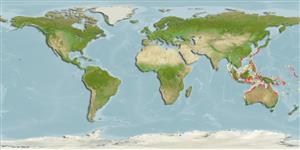Teleostei (teleosts) >
Lophiiformes (Anglerfishes) >
Histiophrynidae (Starfingered frogfishes)
Etymology: Lophiocharon: Greek, lophos = crest + Greek, charon,-onos = showy, attractive (Ref. 45335); hutchinsi: Named for Barry Hutchins of the Western Australian Museum, Perth..
Environment: milieu / climate zone / depth range / distribution range
Ecology
Marine; benthopelagic; depth range 2 - 9 m (Ref. 59208). Tropical
Western Pacific: Australia and Aru Islands in the Arafura Sea.
Size / Weight / Age
Maturity: Lm ? range ? - ? cm
Max length : 4.9 cm SL male/unsexed; (Ref. 59208)
Short description
Identification keys | Morphology | Morphometrics
Dorsal soft rays (total): 13; Anal soft rays: 7. This species is distinguished from its congeners in having a reduced esca (scarcely if at all differentiated from the illicium) and a relatively short illicium, covered from base to tip with small dermal spinules (Ref. 59208).
Specimens collected using rotenone or box dredge on sandy mud, sponge, and seagrass (Ref. 59208).
Life cycle and mating behavior
Maturities | Reproduction | Spawnings | Egg(s) | Fecundities | Larvae
Pietsch, T.W., 2004. A new species of the anglerfish genus Lophiocharon Whitley (Lophiiformes: Antennariidae) from Australian waters. Rec. Australian Museum 56(2):159-162. (Ref. 59208)
IUCN Red List Status (Ref. 130435)
Threat to humans
Harmless
Human uses
Tools
Special reports
Download XML
Internet sources
Estimates based on models
Preferred temperature (Ref.
123201): 24.2 - 29.2, mean 28.4 °C (based on 1520 cells).
Phylogenetic diversity index (Ref.
82804): PD
50 = 0.6250 [Uniqueness, from 0.5 = low to 2.0 = high].
Bayesian length-weight: a=0.01995 (0.00906 - 0.04395), b=3.01 (2.83 - 3.19), in cm total length, based on all LWR estimates for this body shape (Ref.
93245).
Trophic level (Ref.
69278): 3.5 ±0.6 se; based on size and trophs of closest relatives
Resilience (Ref.
120179): High, minimum population doubling time less than 15 months (Fec assumed to be > 10,000).
Fishing Vulnerability (Ref.
59153): Low vulnerability (10 of 100).
